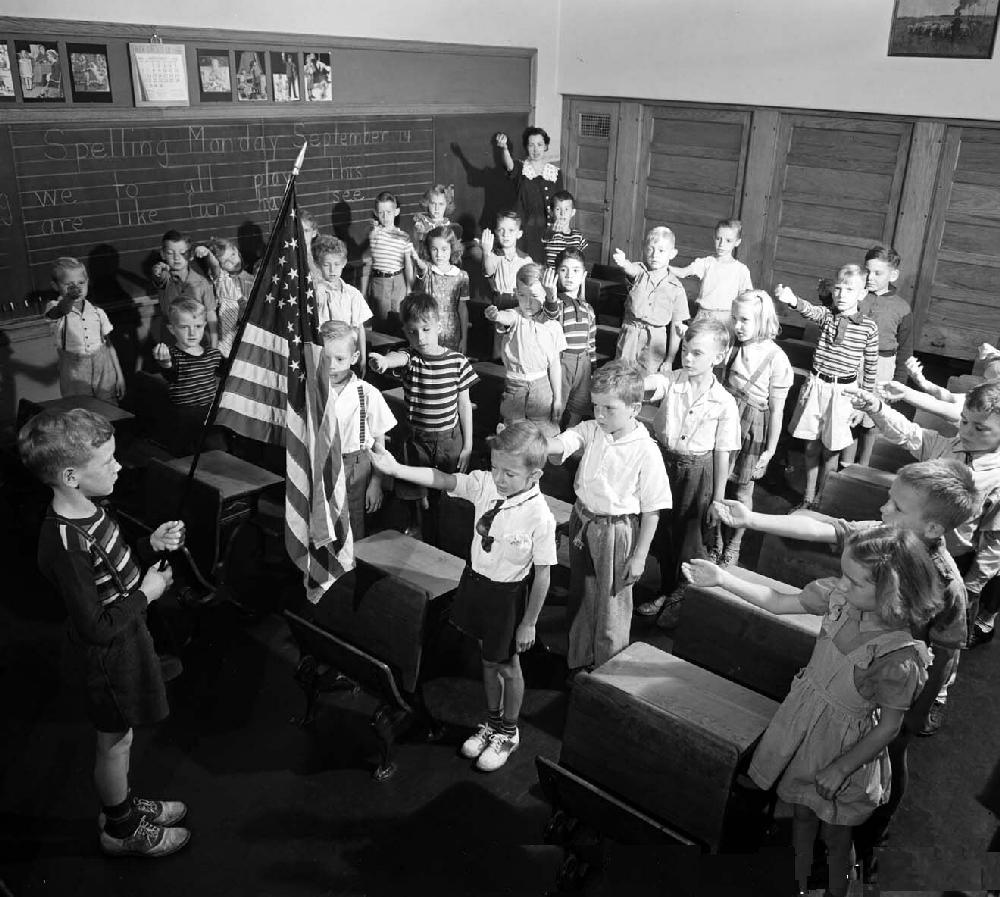
U.S. School Activities and Events: The Pledge of Allegiance

Figure 1.--The wording to the Pledge of Allegience has changed little, but the salute has changed. Many schools adopted a NAZI-like salute--before the NAZIs existed. There was also a Roman salute. The outstreached hand salute came to a screeching halt during World War II. This school in 1943 adopted a palms down version. Schools soon adopted a hand over the heart salute. A reader comments on the children's clothes, "Notice how much more casual the clothing is by 1940s. Only one boy is wearing a tie with a shirt. Also at least one boy is wearing knickers. Many are wearing shorts and it is September." Our reader is correct, although short pants were not seen as casual dress at the time. The boy wearing shorts at the center, for eaple wears shorts.
|
|
American elementary (primary) school children start their day with the The Pledge of Allegiance. This is the afirmation of allegiance to the flag of the United States and the United States Government. It was originally composed by Captain George Thatcher Balch, a Union Army Officer during the Civil War and later taught patriotism in New York City schools, at the time involved in educating large numbers of immigrant children. The pledge used in American schools today was largely devised by Francis Bellamy (1892). The popular Youth's Companion magazine launched a national campaign to introduce the Pledge to schools. Many schools did so and several states required it. The Pledge was formally adopted by the U.S. Congress during World War II (1942). The wording has changed little, but the salute has changed. Many schools adopted a NAZI-like salute--before the NAZIs existed. There was also a Roman salute. The outstreached hand salute came to a screeching halt during World War II. Schools dopted a hand over the heart salute. Congressional adoption aroused a controversy which was finally settled by the Supreme Court. The schools can not compel children to recite the pledge or punish them for not doing so (1943). The official name of The Pledge of Allegiance was adopted 3 years later (1945). The only change was adding "under God" during the post-World War II Red Scare (1945). This was criticised by the secularists. There was also a religious cimplsint bsects like the Seven Days Advintists. The result was a court challenge which was also settled by the Supreme Court. The Pledge continues to draw controversey as left-wing activists and academic increasingly push the disturbing idea that not only patriotism is evil, but the United States has not been a force for good in the world.
HBC-SU

Related Chronolgy Pages in the Boys' Historical Web Site
[Return to the Main Chronology Page]
[The 1900s]
[The 1910s]
[The 1920s]
[The 1930s]
[The 1940s]
[The 1950s]
[The 1960s]
[The 1970s]
[The 1980s]
[The 1990s]
[The 2000s]
Navigate the Relate Boys Historical Clothing Style Pages
[Return to the Main country page]
[Long pants suits]
[Short pants suits]
[Lederhosen]
[Kneesocks]
[Eton suits]
[Jacket and trousers]
[Blazer
[School sandals]
Navigate the Boys' Historical Clothing School Uniform Pages
[Return to the Main American School Activities Page]
[Australia]
[England]
[France]
[Germany]
[Ireland]
[Italy]
[Japan]
[New Zealand]
[Poland]
[Singapore]
[Scotland]
[Singapore]
[United States]
Navigate the HBCSchool Section:
[About Us]
[Activities]
[Chronology]
[Clothing styles]
[Countries]
[Debate]
[Economics]
[Garment]
[Gender]
[Hair]
[History]
[Home trends]
[Literary characters]
[School types]
[Significance]
[Transport and travel
[Uniform regulations]
[Year level]
[Other topics]
[Images]
[Links]
[Registration]
[Tools]
[Return to the Historic Boys' School Home]
Created: 9:38 AM 1/22/2019
Last updated: 9:38 AM 1/22/2019




